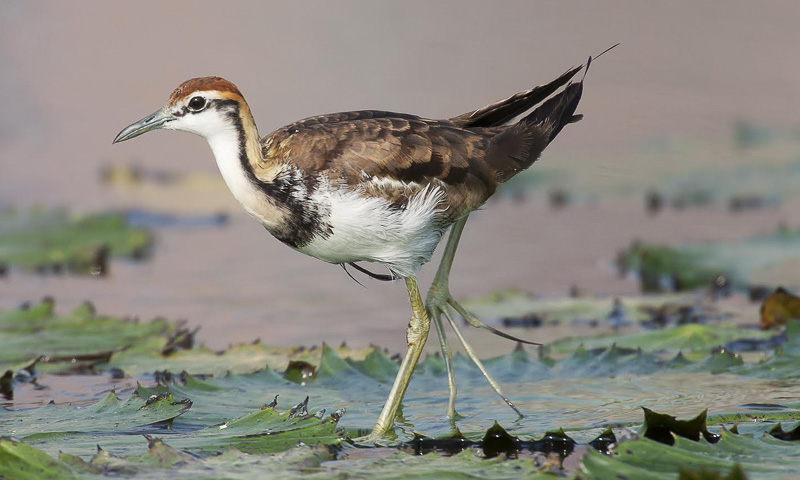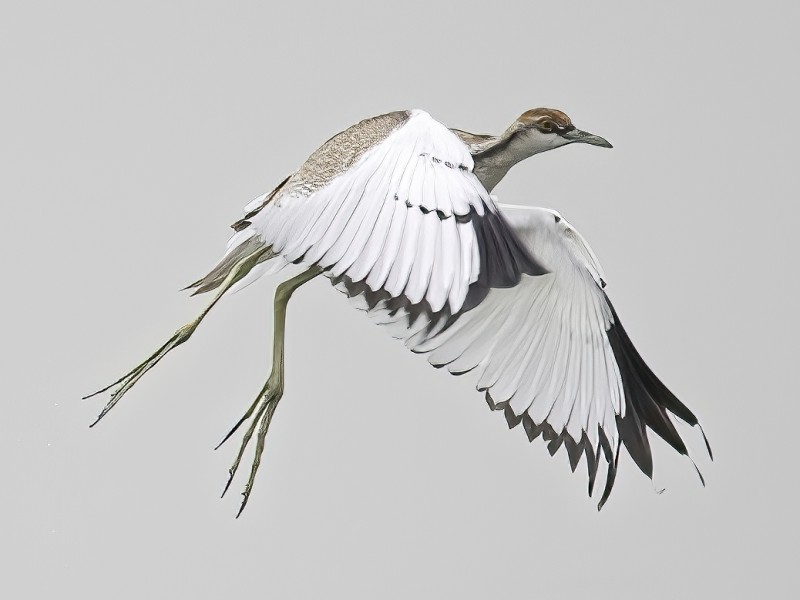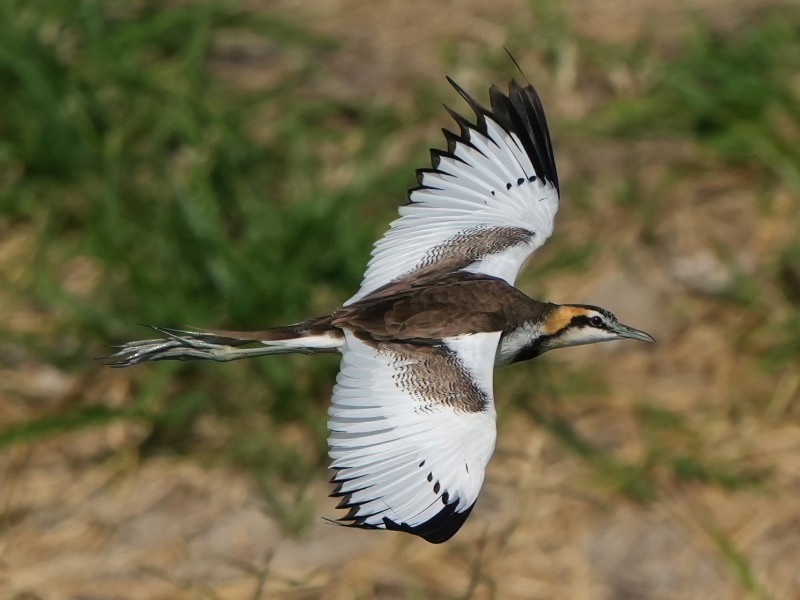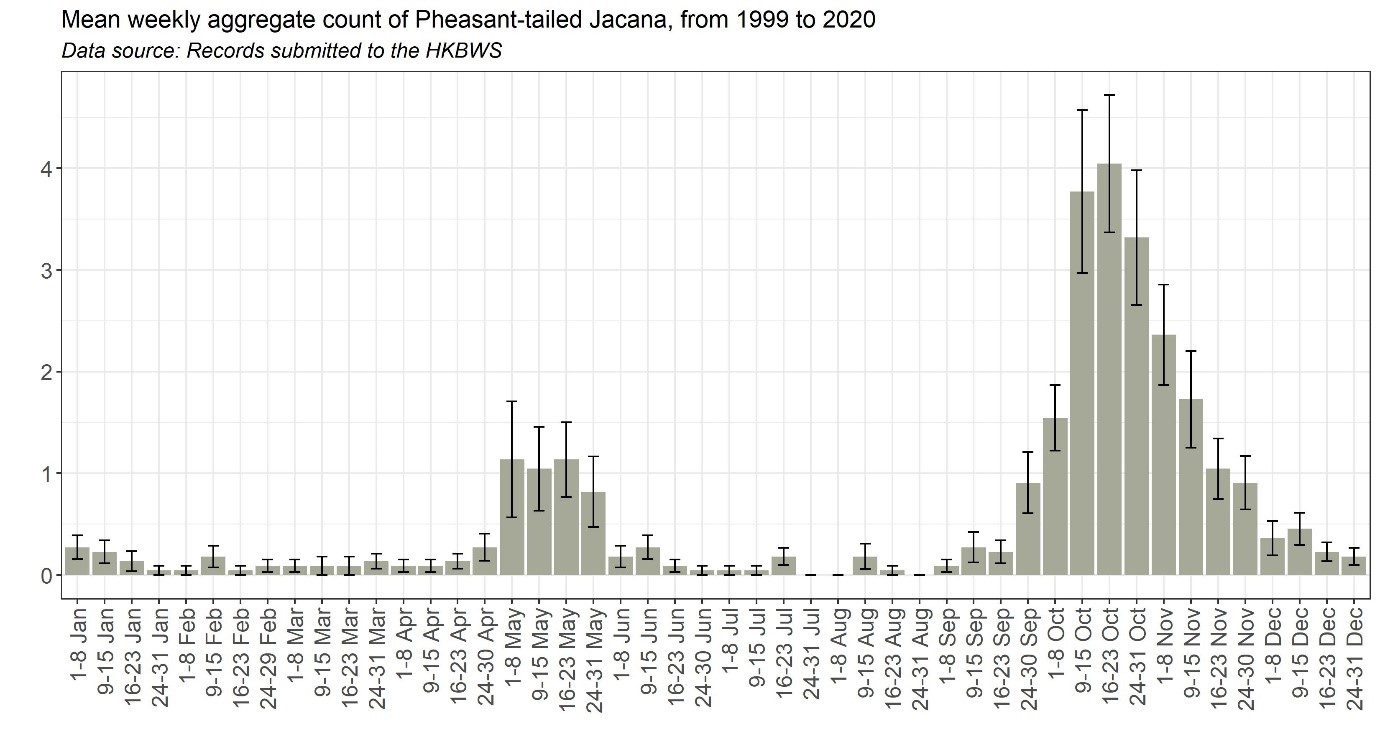Pheasant-tailed Jacana 水雉 Hydrophasianus chirurgus
Category I. Scarce passage migrant, mainly in autumn; much decreased, previously a breeding species.
IDENTIFICATION

Jun. 2011, Martin Hale. Breeding plumage.
30 cm (39-58 cm including tail in breeding plumage). Female larger than male. In breeding plumage white head and fore part of neck separated from yellow hind neck by black line that reaches the nape and joins extensive black on underparts. Dark brown upperparts and long blackish tail that trails beyond feet in flight.

Oct. 2006, Martin Hale. Juvenile.
In non-breeding plumage, face has dark eye stripe from base of bill extending down sides of neck to form a breast band, upperparts are paler. There is a sharp whitish spur at the bend of the wing, though this is not easily visible.
The juvenile has rufous brown crown, broad warm buff fringes to mantle and scapulars, less distinct dark line on head and neck, no yellow on the head and indistinct breast band.

Oct. 2006, Martin Hale. Juvenile.
In flight has largely white flight feathers apart from black tips to primaries and black outer primaries (the outer two with a spatulate extension), black-tipped median and greater primary coverts, very long legs and large feet.

Oct. 2024, Paul Leader. Adult female.
The distinct black on the head and the yellow behind the eye indicates this is an adult female.
VOCALISATIONS
The typical call given in flight, usually when flushed, is a wavering note that falls slightly in pitch.
DISTRIBUTION & HABITAT PREFERENCE
Occurs in freshwater wetlands, particularly marsh, mainly in lowland areas of the northern New Territories. Favoured sites are Mai Po NR, Long Valley and the Lok Ma Chau MTRC Ecological Enhancement Area (EEA); the latter two both contain freshwater marsh that has been created and/or enhanced. Pheasant-tailed Jacana favours ponds that contain lotus and lilies, but not Water Hyacinth Eichornia crassipes.
Birds have also occurred at widespread sites including Lantau and Po Toi, as well as urban sites such as Hong Kong and Victoria Parks.
OCCURRENCE
Vaughan and Jones (1913) referred to Pheasant-tailed Jacana as a common summer visitor to parts of Guangdong, noting that it departed in October, though stragglers remained to the end of November. Breeding occurred in considerable numbers in ponds containing the ‘prickly-leaved lotus’. Herklots (1953) stated that although it was a common breeding bird in Guangdong, he only had two records. However, it seems likely that he was not referring to contemporary evidence of its numbers in Guangdong and was instead basing his assessment on Vaughan and Jones (1913). Dove and Goodhart (1955) referred to three records in autumn, and Macfarlane and Macdonald (1966) listed further records in the same season.
It appears that a decline in numbers in HK may have begun by the time of the publication of Herklots (1953), and the relative paucity of records in the early years of the HKBWS supports this. However, the status of Pheasant-tailed Jacana certainly underwent a significant change after 1974 from that of a breeding bird and passage migrant, with occasional winter records, to being predominantly a scarce autumn passage migrant. The occurrence of breeding was probably responsible for the relatively high number of records during May, late August and September compared to recent years. The peak day count at the time was 15 at Chuk Yuen in June 1969, which compares the peak count this century of nine on 18 October 2003 at Lok Ma Chau Spur Line mitigation wetland.
Carey et al. (2001) stated it was a passage migrant from the second half of April to the middle of June and the second half of September to mid-December, with main passage during October and the first half of November. Usually only singles were recorded, with a now exceptional five birds on 8 October 1994.
Since then, however, the creation or enhancement of wetland habitat at Lok Ma Chau MTRC EEA, Mai Po NR and Long Valley (at which sites 60% of records have occurred) has seen a resurgence of records and a change in its status. It is now most numerous in autumn, mainly in October and November (Figure 1). In addition, in most years since 2007 there have been winter records from December to February, and spring and summer records from the last week of April to mid-July.
BREEDING
Breeding occurred from 1968 to 1974, firstly at what is now Fairview Park housing estate, and latterly at Sha Po. During these years copulation was noted on 14 June 1969 and a newly-hatched chick was seen on 20 July 1969. There is no other information from this time but, like Greater Painted-snipe, it is polyandrous in wetlands of sufficient quality.
The species’ decline as a breeding species has not reversed itself, despite the provision of freshwater marsh with emergent and floating vegetation, including Lotus Nelumbo nucifera ; in addition, it can be assumed that there has been a similar regional decline, at least in southern Guangdong where rapid development since 1980 has led to the loss of substantial areas of freshwater wetland.
BEHAVIOUR, FORAGING & DIET
Has been noted feeding on insects and small invertebrates gleaned from the water surface and the roots and leaves of aquatic vegetation. As a migratory species of jacana, this is a strong flier, and it is often flushed from marshy areas when it utters its distinctive call.
RANGE & SYSTEMATICS
Monotypic. East Afghanistan east through the Indian subcontinent to south China and through Indochina and southeast Asia to the Philippines, Sumatra and Java. Northerly populations are migratory, including most of the Chinese population, which occurs from the Yangtze floodplain south, including Hainan and Taiwan (Jenni and Kirwan 2020). In China breeds and migrates southeast of a line from Yunnan to Hebei; small numbers winter in the south (Liu and Chen 2021).
CONSERVATION STATUS
IUCN: Least Concern. Population trend decreasing.
Figure 1.

Carey, G. J., M. L. Chalmers, D. A. Diskin, P. R. Kennerley, P. J. Leader, M. R. Leven, R. W. Lewthwaite, D. S. Melville, M. Turnbull and L. Young (2001). The Avifauna of Hong Kong. Hong Kong Bird Watching Society, Hong Kong.
Dove, R. S. and H. J. Goodhart (1955). Field observations from the Colony of Hong Kong. Ibis 97: 311-340.
Herklots, G. A. C. (1953). Hong Kong Birds. South China Morning Post, Hong Kong.
Jenni, D. A. and G. M. Kirwan (2020). Pheasant-tailed Jacana (Hydrophasianus chirurgus), version 1.0. In Birds of the World (J. del Hoyo, A. Elliott, J. Sargatal, D. A. Christie, and E. de Juana, Editors). Cornell Lab of Ornithology, Ithaca, NY, USA. https://doi.org/10.2173/bow.phtjac1.01
Liu, Y. and S. H. Chen (eds) (2021). The CNG Field Guide to the Birds of China (in Chinese). Hunan Science and Technology Publication House, Changsha.
Macfarlane, A. M. and A. D. Macdonald, revised by Caunter, J. R. L. and A. M. Macfarlane (1966). An Annotated Check-list of the Birds of Hong Kong. Hong Kong Bird Watching Society, Hong Kong.
Vaughan, R. E. and K. H. Jones (1913). The birds of Hong Kong, Macao and the West River or Si Kiang in South-East China, with special reference to their nidification and seasonal movements. Ibis 1913: 17-76, 163-201, 351-384.

